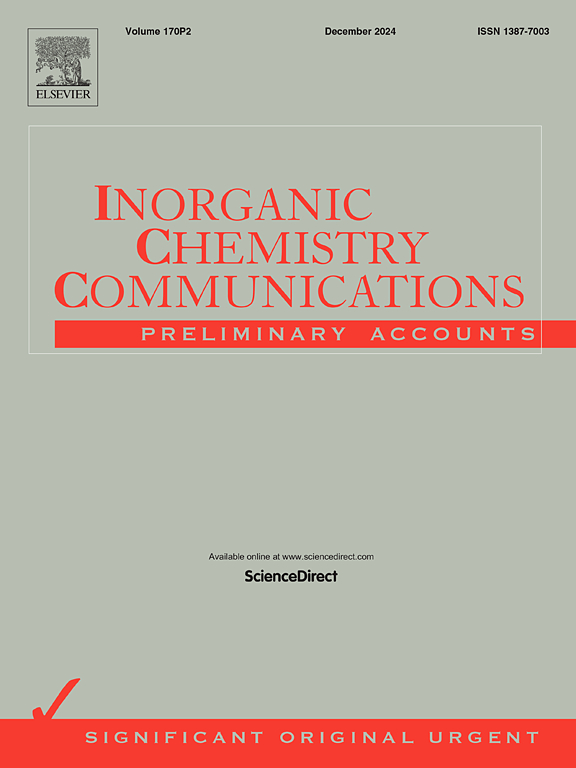Synthesis of nano-structured graphite-like carbon nitride (g-C4N3) for enhanced lead (II) adsorption in wastewater treatment
IF 4.4
3区 化学
Q1 CHEMISTRY, INORGANIC & NUCLEAR
引用次数: 0
Abstract
Modern water treatment methods are required since the population rise, technological development, and environmental harm have made water contamination more severe. These features demand rather sophisticated and highly advanced water filtering materials. This work demonstrates the fast and effective adsorption of graphite-like carbon nitride (g-C4N3) to remove Pb (II) from water. Fourier-transform infrared spectroscopy (FTIR), powder X-ray diffraction (XRD), high-resolution X-ray photoelectron spectroscopy (XPS), field emission scanning electron microscopy (FE-SEM), and energy dispersive spectroscopy (EDS) were employed to thoroughly examine the chemical bonds, crystalline structure, atomic and chemical states, morphology, and elemental composition, respectively.
Several adsorption experiments have systematically investigated the influence of the initial concentration of Pb (II) ions, adsorbent dosage, contact duration, and solution pH on the effectiveness of the adsorption process. The optimal conditions were determined based on Pb (II) concentration, contact duration, pH, and dosages of 100 mg/L, 60 min, 10 g, and 0.03 g. The Langmuir and Freundlich isotherm approaches effectively match the experimental results, as indicated by the regression coefficient (R2). Meanwhile, the Pseudo-first-order and pseudo-second-order approaches assessed the adsorption rate and metal ion sorption mechanism. The closeness in adsorption capacities (qe) of both adsorbents aligns well with the experimental qe value.
In addition, the Pb (II) removal efficacy of g-C4N3 has been compared with that of nanographite-like carbon nitride (g-C3N4) and carbon nanotubes (CNT) as well as g-C3N4. The two adsorbent pseudo-second-order kinetics matched the kinetic adsorption values obtained. The adsorbents for g-C3N4 and g-C4N3 displayed relatively strong Pb adsorption capabilities of 162 and 185 mg/g, respectively. This points to tremendous potential for the g-C4N3 adsorbent in wastewater treatment, providing hope for the fight against water pollution.

纳米结构类石墨氮化碳(g-C4N3)的合成及其在污水处理中对铅(II)的吸附
由于人口的增加、技术的发展和环境的危害使水污染更加严重,需要现代的水处理方法。这些特点需要相当复杂和高度先进的水过滤材料。这项工作证明了石墨样氮化碳(g-C4N3)对水中铅(II)的快速有效吸附。采用傅里叶变换红外光谱(FTIR)、粉末x射线衍射(XRD)、高分辨率x射线光电子能谱(XPS)、场发射扫描电镜(FE-SEM)和能量色散光谱(EDS)分别对化合物的化学键、晶体结构、原子和化学状态、形貌和元素组成进行了全面的研究。几个吸附实验系统地研究了Pb (II)离子的初始浓度、吸附剂用量、接触时间和溶液pH对吸附过程效果的影响。以Pb (II)浓度、接触时间、pH、投加量(100 mg/L、60 min、10 g、0.03 g)为条件确定最佳条件。Langmuir和Freundlich等温线方法与实验结果有效匹配,回归系数R2表明。同时,采用拟一级和拟二级方法对吸附速率和金属离子吸附机理进行了评价。两种吸附剂的吸附量(qe)相近,与实验qe值吻合较好。此外,还比较了g-C4N3与纳米石墨样氮化碳(g-C3N4)、碳纳米管(CNT)和g-C3N4对Pb (II)的去除效果。两种吸附剂的准二级动力学与得到的动力学吸附值相匹配。g- c3n4和g- c4n3吸附剂对Pb的吸附能力较强,分别为162和185 mg/g。这表明g-C4N3吸附剂在废水处理中的巨大潜力,为防治水污染提供了希望。
本文章由计算机程序翻译,如有差异,请以英文原文为准。
求助全文
约1分钟内获得全文
求助全文
来源期刊

Inorganic Chemistry Communications
化学-无机化学与核化学
CiteScore
5.50
自引率
7.90%
发文量
1013
审稿时长
53 days
期刊介绍:
Launched in January 1998, Inorganic Chemistry Communications is an international journal dedicated to the rapid publication of short communications in the major areas of inorganic, organometallic and supramolecular chemistry. Topics include synthetic and reaction chemistry, kinetics and mechanisms of reactions, bioinorganic chemistry, photochemistry and the use of metal and organometallic compounds in stoichiometric and catalytic synthesis or organic compounds.
 求助内容:
求助内容: 应助结果提醒方式:
应助结果提醒方式:


